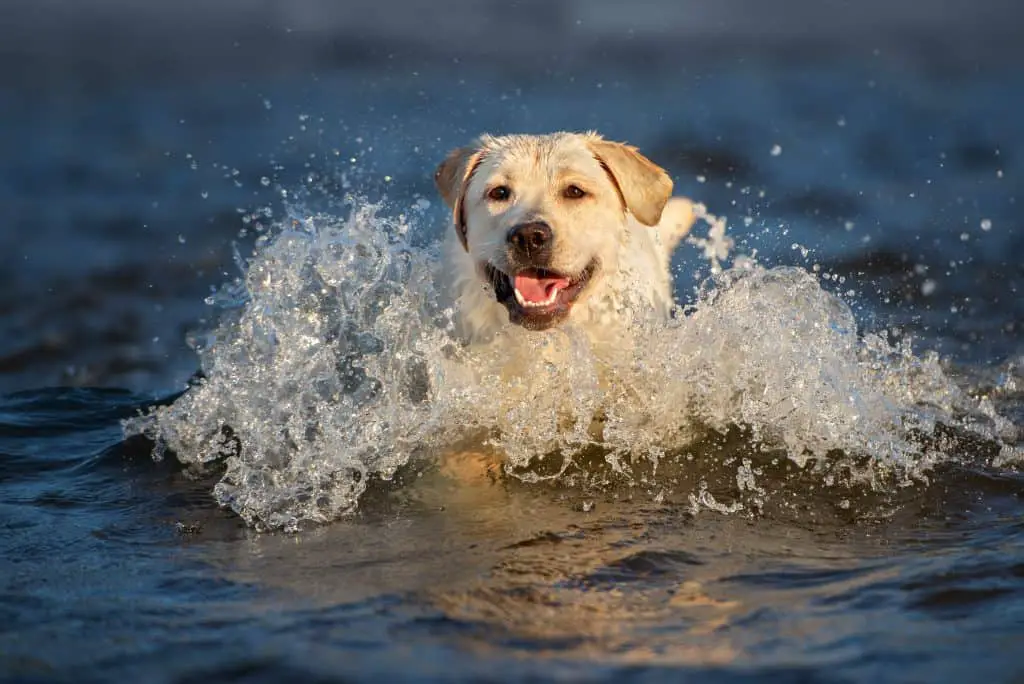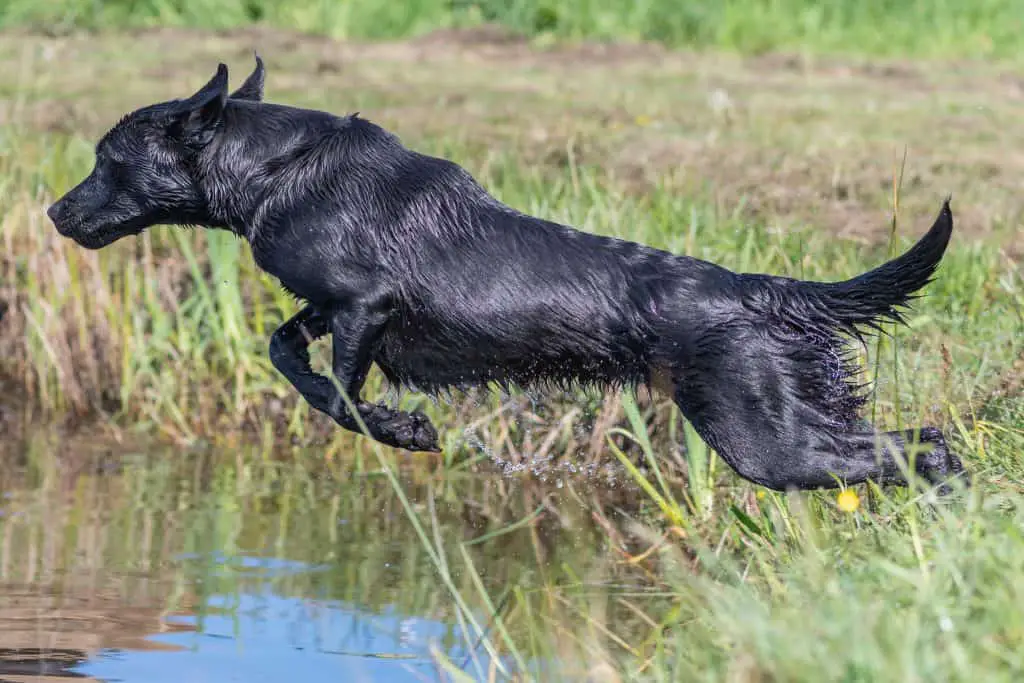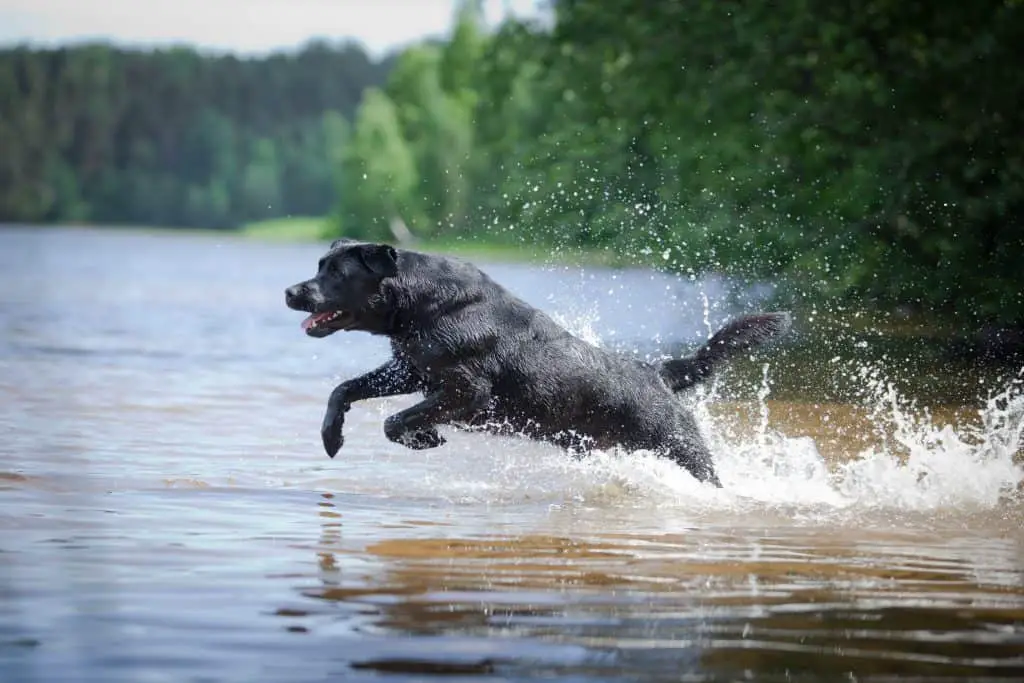
If you are someone who adores water and loves to go for a swim now and then, you might be excited at the prospect of owning a pet that does the same. Fortunately, you do not have to look too hard to find one. Labrador retrievers, which make great pets for several reasons, are also known to be extremely fond of water. But why do Labrador retrievers love water so much?
The answer is simple, this breed was made for swimming. It is a thoroughly enjoyable sight to watch a lab get into the water and playfully splash around, having a lot of fun. As with any kind of animal behavior, there is science behind the natural love for water found in these widely sought-after dogs.
Let us take a brief look at the lab’s origin and then find out how they are naturally designed to spend hours in water. Also, read on for tips for introducing your lab to water.

Labrador Origins
If we go back to the lineage of Labrador retrievers, it is easy to understand why these intelligent dogs love the water so much. Going back to as early as the 18th century when Labradors were used by fishermen of the Labrador Sea, in northern Canada. These dogs would help fishermen bring back fish and other aquatic animals from the water.
This is one of the reasons why they fall into the ‘retriever’ category as they were always quick at looking for fish that may have fallen out of the nets of the fishermen and bringing them back to the shore in no time. This is how labs developed their love for the water.
These traits were acknowledged by the fishermen who started breeding only those labs who were good at getting the catch out of the sea. Thus, over the years, the swimming gene began to preside over the other genes. Fast forward to the 21st century, and your lab is a natural swimming buddy for you. Read more about the history of Labradors
Labs Were Bred to Love Swimming
As civilization progressed, the expectations that humans had of these dogs began to change as well. Although the earliest Labradors majorly belonged to the working class, soon they began to be recognized for other qualities. Their intelligence, love for fun, adaptability, and playfulness all added up to the kind of pet dog the elite English household preferred.
Fortunately, this noble class of people also preferred dogs that could swim. It made them easier to take them along on outings near water bodies and have them handy on hunting grounds where the Labradors would jump into lakes to retrieve prey that they had fallen into the water. Thus, the breeding of Labradors was improvised to continue to include those ancestral genes that loved swimming.
Waterproof Coat
Do you tend to complain about the amount of hair that your lab sheds? Well, there is a good reason for that. Labradors have a double coat that makes their skin waterproof. The outer coat, which makes a lovely mess in your house, is designed to repel water and keep the inner layer dry. The inner coat is smooth and soft and is the one that regulates the dog’s temperature and helps them stay warm in cold temperatures. So, if you and your lab decide on splashing around in cold waters someday, you will find yourself longing to go back ashore much sooner than your dog. Click here to read about labrador shedding
Webbed Paws for an Easy Swim
If you have ever looked closely at those adorable labrador paws, you must have seen a thin membrane in between the toes. This membrane gives your dog’s feet a webbed look. As with all other traits, the webbed toes are not just about the looks, either. They are the reason your beloved pet is so good at swimming.
You may find webbed feet with other animals, mainly amphibians that spend a good amount of time in water bodies as well as on land. Well, the lab’s webbed toes may not be as sophisticated as that class of animals, but they are good enough for an easy swim in the lake or shallow waters.
What’s more, labs usually have large paws, which when combined with their webbed structure, help them swim much faster. No wonder then, that they can fetch that ball you playfully throw in the lake much quicker than you could have thought of.
Thick and Powerful Tail
Swimming vessels need a rudder that steers them in the right direction when in water. If it is true for boats, it is true for animals, too. What better rudder can a Labrador wish for when nature has given them a powerful tail? Yes, this tail is so thick and so strong that if you leave your lab alone in a small, congested house, it may (unknowingly) topple everything that comes in its tail’s way. But coming back to swimming, this tail is what helps the dog find its way rapidly through a stream of water.

Does Swimming Come Naturally to Labs?
Yes, Labradors have a natural affinity for water, it is enough that your Labrador is near a pool or lake so that he wants to go swimming, many Labradors even swim in the sea. This is why it is common for lifeguards to use Labradors as rescue dogs. This breed of dog sometimes looks like more otters than dogs. Now some Labradors love water more than others. American Labradors are better Labradors than English Labradors. This is because American Labradors come from a lineage of working dogs, which accompany hunters on their excursions, while the English lineage comes from dogs bred to compete in dog shows. Related post: English vs American Labrador Retriever
If you are unsure of your lab’s attachment to water, here are tips to gently introduce the dog to the world of swimming.
How to Introduce Your Lab to Water?
Every good dog training practice follows two basic principles, one, start early but slow, and two, load up on rewards for good behavior. When it comes to introducing your lab to water, the theory is no different. It is best to start this training in a small kiddie pool in your backyard instead of visiting a larger water body right away.
Fill up a small, shallow pool with enough water to just wet its paws, and try to get it excited about the water by holding a plaything in the pool and beckoning it to fetch it for you. Being natural retrievers, the dog is bound to promptly start thinking about ways to get into the water and fetch the toy for you. Gradually, it would go into the pool, one paw at a time. The important thing is to let it take its time and not rush it until it feels the natural inclination to go and relax in the pool.
In the next few days, you could take the lab to a shallow lake, and let it play around the lake-shore border until it finds the confidence to get into the water. And of course, do not forget to acknowledge and reward the small achievements.

Do All Labs Love to Get into Water?
Mostly yes, but not every lab loves to swim. But, every dog has a unique personality. Although labs might be naturally great at swimming, they may not necessarily always like to swim. Some labs have been seen to display a trait wherein they do not wish to go anywhere near water even when you try to introduce them into the water the right way. It either has a fear of water from a previously negative experience or it is just that particular dog’s personality. If this sounds like your dog, let it be. Let the lab be wherever it finds happiness.
Safety Precautions for Your Lab During a Swim
Even though your lab may be a natural swimmer, there is no such thing as being overprotective when it comes to letting your dog in or near water. Safety practices begin when you first teach your dog to swim.
Ensure you teach your lab how to get out of the water and not just how to get in. This way, even if your dog ever swims alone, without you to watch over it, it will know how to keep itself safe. Do not force your dog to get into deep waters unless it is ready. Let your lab decide how far it wants to go. Remember, they have an instinct for swimming and will not venture into dangerous tides by themselves.
Swimming equipment is not always necessary if you and your dog are more likely to spend time near the shore, but if you are out on a boat, a dog life jacket for your lab is recommended. This way, you and your dog can both enjoy deeper waters without worrying about drowning. Having said that, it is never wise to leave your lab alone in the water. Be watchful. Be safe.
Click here to find the best outdoor gear for Labradors

Have a Great Swim!
Every dog owner brags about taking their dog to the park for a walk. But if you own a Labrador, you can go one step further and take your dog for a swim instead! Watching a Labrador puppy play in the water is one of the most cuddly, affectionate, and proud feelings for any dog lover.
As the puppy grows into an adult, its innate swimming abilities become more profound, and then you just cannot wait to go for a swim now and then with your four-legged buddy. Just let your lab follow its instincts, ensure you take all the safety precautions, and enjoy your swim!
Related post: Are Labradors Good Guard Dogs?
Reference Links:


